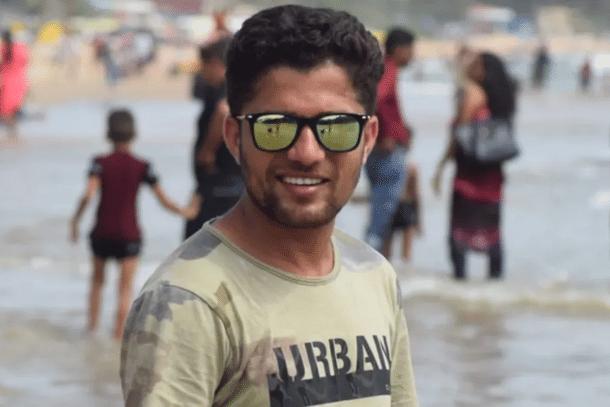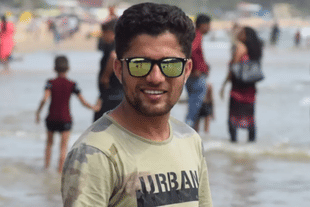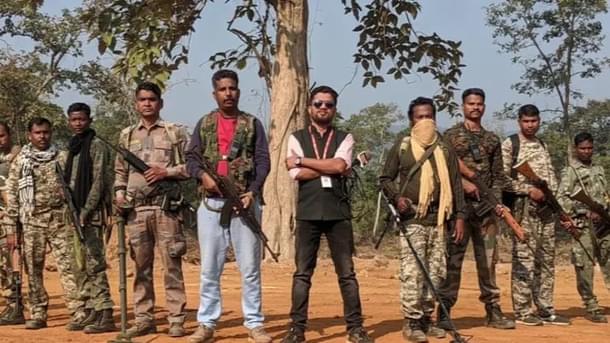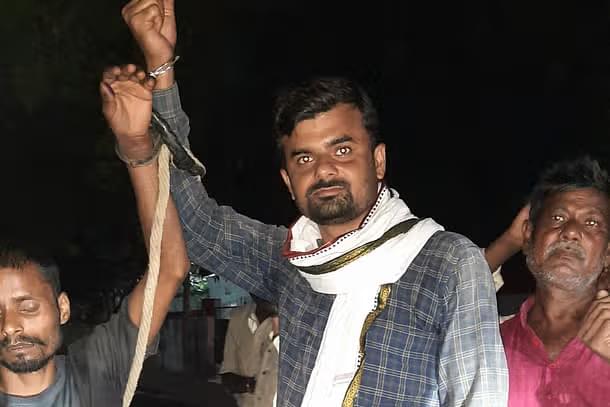Culture
Chhattisgarh Journalist's Death: What Makes Reporting In India's Hinterlands A Dangerous Affair
Abhishek Kumar
Jan 15, 2025, 12:20 PM | Updated Jan 17, 2025, 03:09 PM IST
Save & read from anywhere!
Bookmark stories for easy access on any device or the Swarajya app.


The year 2025 began with deeply disheartening news for media professionals.
Mukesh Chandrakar, a prominent journalist from Naxal-affected Bastar, was brutally killed, allegedly by Congress leader and contractor Suresh Chandrakar, who was also his cousin.
Mukesh had exposed corruption on his YouTube channel, "Bastar Junction," highlighting alleged irregularities in a road project linked to Suresh. The project’s cost had reportedly been inflated from Rs 56 crore to Rs 120 crore, with over 90 per cent of funds disbursed against norms. Mainstream media picked up the story, prompting an investigation by the Bharatiya Janata Party (BJP) government in Chhattisgarh.
Suresh blamed Mukesh for this 'exposé' and is said to have called him on the eve of 1 January 2025 for a ‘discussion.' The meeting escalated into violence, resulting in Mukesh’s murder.
The post-mortem revealed horrific injuries: multiple weapons were used, his heart ripped out, a broken neck, and 15 fractures. His body was reportedly buried in a newly built septic tank.
Earlier, Mukesh, had put out reports criticising both Maoists and the administration’s 'high-handedness' in handling a delicate internal security issue.
Mukesh gained fame in 2021 for facilitating negotiations between Maoists and the government to secure the release of abducted Central Reserve Police Force (CRPF) soldier Rakeshwar Singh Manhas.

Mukesh’s murder drew the national attention. Ironically, the same news media that would hesitate even to reimburse Mukesh’s fuel expenses for reporting work was now debating press freedom in India and the plight of journalists working in the hinterlands.
Stringers Vs Mainstream Journalists
Mukesh is often referred to as a freelance journalist. However, professionals like him, who provide local news to television channels and newspapers, are more commonly known as stringers.
The world of stringers operates under unique values. While the moral guidelines of editorial boards may serve as a guiding principle, these ideals rarely translate faithfully into real-life scenarios.
In this intricate ecosystem, a stringer is far more than a journalist. They often wear multiple hats — revolutionary, advocate for the people, informal mediator between politicians and the media, land broker, facilitator for locals in administrative matters, and ad revenue generator for their organisations.
This culture has roots in old-school journalism, where reporters stayed on 24-hour alert for stories on corruption, caste conflicts, or security operations.
Before the advent of online platforms like WhatsApp, these reporters relied on sources within their areas, often compensating them informally.
Some of the most impactful exposés emerged from these sources, with reporters leading the investigations. However, once the stories were handed over, anchors sitting in studios took the spotlight, leaving reporters as mere contributors and sources as uncredited enablers. This pattern persists even in today’s internet-driven age.
Traditionally, reporters would graduate to anchor roles after years of groundwork. However, the rise of satellite TV and the growing demand for younger, tech-savvy professionals with better access to newsmakers shifted the industry dynamic. Younger anchors with foreign education sidelined seasoned field reporters.
Many reporters who began their careers in the early 2000s remain on the ground, while fresh foreign-educated graduates occupy prime studio positions.
In the public eye, reporters are often seen as more dedicated to uncovering ground realities, despite earning far less than their anchor counterparts. While a prime-time anchor taking inputs from reporters is still the norm, there have been remarkable changes in news-gathering.
Reporters have their own WhatsApp groups for videos, photographs, and other information. This material forms the basis for their reports, which they file to their organisations.
The 'sources' of the past have been replaced by individuals active on these platforms — people who often seek justice or visibility for their grievances. Consequently, keeping a close watch on one’s phone has become an essential part of a reporter’s job.
However, all this work does not guarantee a stable job. There is always a feeling that it may all come crashing down one day, especially in the corporatised mainstream media ecosystem.
Soundbites and sensationalism have grown stronger in the news stream too. Saas-bahu series and cine stars’ personal lives now share the spotlight with serious journalism.
Journalism is no longer associated with Investigative reporting aimed at driving systemic change. Hence, the need for seasoned reporters is declining, while the relevance of professionals who provide news that generates higher television rating points (TRP) is growing.
More and more channels, across the national, state, and regional levels, are now doing away with reporters and relying more on those who provide sensationalist news bites. Election cycles also have a big role to play in this shift.
Reporters In Stringers' Shoes
Much like political consultants, reporters are often hired by organisations for specific periods — sometimes under the guise of a permanent job — and then let go once their utility, such as during an election cycle, comes to an end.
However, these reporters don’t disappear from the scene entirely. Many transition into roles as stringers. While their job descriptions remain largely the same, the dynamics of their professional lives shift dramatically. They must now compete with seasoned stringers who have spent years mastering the trade and building extensive local networks.
Stringers are tasked with gathering stories, often reduced to "examples," on topics that captivate audiences, such as corruption, political developments, and social issues. They are also expected to produce softer, human-interest stories focused on themes like caste, women’s empowerment, and government schemes.
To stay ahead, stringers position themselves at hospitals, courts, and government or private offices, ever alert for leads to share in social media groups. Every instance of systemic inefficiency or misfortune becomes a potential story.
Systemic Oppression Of Stringers
Stringers are constantly on the move, kick-starting their bikes and rushing to chase stories or trail local political leaders. On average, stringers (mainly men) cover between 150 and 200 kilometres a day, incurring fuel costs of Rs 300 to Rs 500.
Despite their efforts, not every day yields a story. Many fail to meet the typical target of four to five stories daily, as their work's fate depends on their seniors' decisions. Having three stories approved in a single day is considered an achievement, though this success has diminishing returns.
Some of the stringers this writer spoke to say that their payments have significantly declined over the past decade.
A stringer in Bihar’s Sasaram district would earn Rs 2,000 to Rs 2,500 per story picked up by national media, though selection was rare — perhaps once every 15 days.
Regional outlets, meanwhile, offered more opportunities, with payments that at least covered basic food and travel expenses. But the influx of stringers, driven by channels laying off full-time reporters, created a saturated pool, driving costs down. Today, in much of the Hindi-speaking belt, Rs 50 per story has become the standard rate.
Stories accompanied by photos or videos can double the payment. On a good day, a stringer might earn Rs 500, but on bad days, they may earn nothing at all.
For the average stringer, even the process of receiving payment is arduous. They get their earnings deposited into their bank accounts, which can take months. They must maintain meticulous records of published stories and submit them as proof. This bureaucratic process is followed by repeated pleas to editors and administrators in WhatsApp groups.
Most of these appeals fall on deaf ears until some emergency arises. Payments, when they arrive, are often delayed by months. A three-month delay is typical, but instances of year-long waits are not uncommon.
One particularly grim case involved a stringer who was paid only after being in a coma for 20 days following an accident. The news channel’s sole contribution to his plight was arranging a call to ensure his admission to a hospital. It was this timely intervention — and the "influence" wielded by the channel — that ensured the doctors prioritised his treatment.
Low Pay Incentivises Backdoor Income
Influence acts as an incentive for many newcomers entering the industry. These youngsters, often yet to complete their coursework or receive their degrees, seek respect, which they believe is acquired by aligning with individuals who hold sway in local socio-political circles.
Without proper identity cards, they forfeit any legal benefits of being employees. However, they use the access to authorities that comes with being in the media to assert influence in local affairs. Sometimes this influence stems from goodwill, while at other times, it is sheer sycophancy.
This access gives stringers early knowledge of developments such as irrigation projects, new transport corridors, hotel chains, and hospitals. Driven by the need to support their families, many stringers become mediators or brokers to resolve local issues.
For instance, if someone wants to meet government officers for work, a stringer often serves as a facilitator. If a land buyer needs more information, a stringer may prove more reliable than a broker — often doubling as one.
Stringers also engage in political work. They help wealthy businesspeople meet local members of the legislative assembly and parliament (MLAs and MPs) to secure business deals or election tickets. This writer witnessed such a case in the Supaul district of Bihar.
Stringers often become embroiled in local rivalries, developing affinities for specific political groups at the village or legislative constituency levels.
Mithun Mishra, a stringer who stumbled into the field by chance, observed:
“There are local journalists (stringers) who cover scams or malfeasance associated with a particular politician while ignoring other politicians. In lieu of that, they take money from their rivals.”
This manipulation is a common way for underpaid stringers to make ends meet. Such activities intensify during elections, which offer lucrative opportunities.
Stringers also facilitate connections between local businesspeople, politicians, and media outlets for advertisements, earning a 15 per cent commission. While seniors sometimes claim the credit and the cut, this practice remains an efficient source of income for many stringers.
The late journalist Rajdeo Ranjan from Siwan, who was killed in 2016, was renowned for his skill in securing advertising revenue. He achieved this by navigating local political networks.
Though Mohammed Shahabuddin, a former strongman from Siwan, was accused of Ranjan's murder, local voices suggest that Ranjan’s involvement in political disputes with Laddan Mian, a Shahabuddin associate, played a role.
Many senior journalists this writer spoke to estimate that over 70 per cent of stringers are now intertwined with local political cultures.
A stringer summed up the dire situation:
“The channel gives us an ID and says we are on our own. We have to work for the channel but get no financial incentive to do so. The channel also knows that if it does not give us enough food on the plate, we’ll still find a way to feed our families. It just leaves us to hunt for food on our own.”
It remains unclear whether reporters initiated the politicization of their profession and were subsequently offered lower wages by organizations, or if they started with low pay and were compelled to adopt alternative income strategies. This conundrum resembles a classic chicken-and-egg scenario.
“A simple labourer charges Rs 400-700 per day, yet we don't even earn that minimum wage. Not everyone can remain honest or committed to a single source of income,” said the stringer from Sasaram.
Social Media's Role
The shift toward digital platforms has created a new form of journalism, blending reporting with entrepreneurship. Independent journalists now use platforms like YouTube, X, and Instagram to build their brands.
While this model offers editorial independence, it also makes financial sustainability the journalist’s responsibility — much like their situation as stringers. All they need is a decent camera and a collar mic, though many start with phone cameras. As social media revenues grow, they upgrade their equipment.
This approach succeeds because national election coverage often focuses on macro issues that don’t impact people’s daily lives. Local digital channels address grassroots problems, making their content more relatable.
All they need to do is open the camera app, record, highlight the difficulties faced by people, and question authorities. The public finds these videos far more relatable than the 9 pm prime-time debates. These locally-focused videos often gain more traction than national news stories like “Modi thrashed Rahul in Parliament.”
For example, Mithun Mishra of Bihar Wala News gained prominence through one of his initial stings, such as exposing a home guard officer taking a Rs 400 bribe from a poor family. His video went viral, launching his journey as a 'citizen journalist.'
Mishra’s rise continued as he aired grievances about local projects’ inefficiency. When he began, Mishra did not have a proper microphone, and recording was done using a phone. He had to raise his pitch to be heard well, which later became his trademark. He is now held by many to be Manish Kashyap 2.0 in the making.
Mishra's videos exposing corruption gained local fame and were often noticed by leaders.
One eventful day, he caught hold of Christian conversion agents and aired his confrontational conversation with them. Though it helped him gain national fame, it also led to his arrest, with 16 charges filed against him for inciting people against law enforcement agencies.

After a national outcry, police downgraded Mishra from the main accused to an accused, reducing the charges against him.
When Bihar Chief Minister Nitish Kumar visited Muzaffarpur, the local administration hurriedly renovated roads and initiated developmental work to create a positive impression. However, the situation reverted to its original state shortly after his visit. Mishra highlighted this regression in one of his reels.
The Rashtriya Janata Dal (RJD) took note of it, and Mishra now fears potential retaliation from the state administration, although he acknowledges the likelihood is low.
Mishra admits that the issue of reporters turning into political agents also applies to modern-day media entrepreneurs. This phenomenon reflects the precarious nature of stringer culture but on a broader scale. Independent journalists face the dual challenge of producing impactful stories while generating revenue.
YouTubers have gained credibility among local audiences because they are perceived as being free from traditional media bias. The local focus adds relevance and elevates the status of these YouTube channels.
However, this has led to the same old practices infiltrating these platforms. In his early days, Mishra was tempted by offers from established voices but realized within a week that such an approach was not for him. To this day, he avoids interviewing local politicians.
The realities of local journalism leave little room for executing plans without engaging powerful local entities. Whether acknowledged or not, reporters, stringers, and YouTube journalists often lack institutional protection. Unlike traditional media organisations, independent creators do not have access to legal aid, security measures, or financial backing, leaving them vulnerable to both legal and physical threats.
Mukesh Chandrakar, praised by his colleagues for his journalistic integrity, exemplified goodwill and trust in negotiating with Maoists to secure the release of a soldier. His family currently enjoys bipartisan support.
Let us hope justice is served for his departed soul. The true tribute to him would be the establishment of a framework that ensures transparency and ethical journalism.
India has too many mafias to confront, making honesty a near-impossible feat without institutional support or superhuman resolve — the kind Mukesh demonstrated.
Abhishek is Staff Writer at Swarajya.





